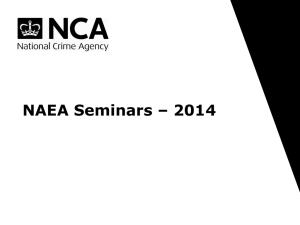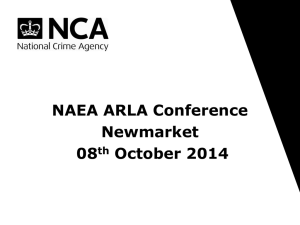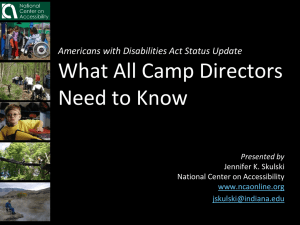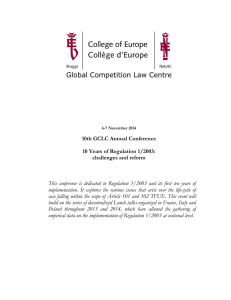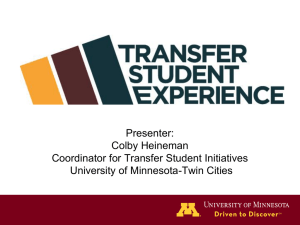Test Security
advertisement
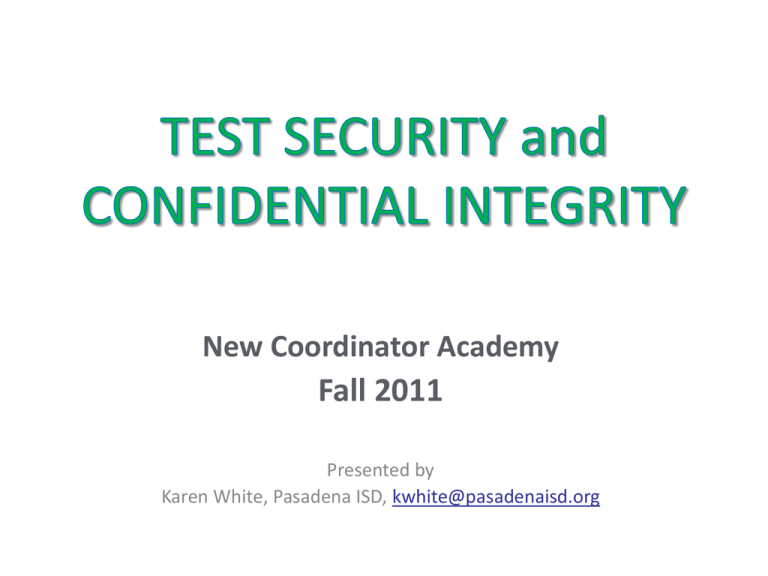
New Coordinator Academy Fall 2011 Presented by Karen White, Pasadena ISD, kwhite@pasadenaisd.org Test Security, NCA, Fall 2011 2 • Attend all District Coordinator Training (both optional and required) • View all TETNs • Read the published manuals at all levels –the DCCM, the , and ALL Test Administrator Manuals – STAAR/EOC, TAKS, TELPAS, Field Tests, etc. • Evaluate the testing incidents and reportable irregularities that have occurred in your district in the past. Test Security, NCA, Fall 2011 3 • Enlist the assistance of your Central Administration at all levels – to assist with testing, monitoring, district-level “Super Monitors”, and so forth. • Join your Regional Testing Supervisors group • Call your ESC Testing Coordinator, TEA, and Pearson. • Phone a Friend. Test Security, NCA, Fall 2011 4 Communicate with critical departments in your district – Special Education, Bilingual/ESL, Section 504, and so forth. Plan to cofacilitate training with other departments, if necessary, so everyone is on the same page. This is a model for the “Assessment Team” that is vital on a campus. Test Security, NCA, Fall 2011 5 Effective TOOLS and RULES Test Security, NCA, Fall 2011 6 • Provide your CTCs with a schedule of required trainings for the entire year. Always plan for make-up sessions. • Communicate your expectations at the beginning of the year – all CTCs must attend, arrive on time, bring DCCM/other required materials, etc. • Provide concrete examples and scenarios. Review the manuals at your trainings – do NOT rely solely upon a Power Point (you are setting the example for their campus trainings). Review answer docs, Calendar of Events, dates to return materials, etc. during your training. Test Security, NCA, Fall 2011 7 • Provide a ,a even a , and . • Three TEA web-based Test Security Modules should be used as a supplement to the district/campus training materials. (Active Monitoring, Distribution of Test Materials, and Proper Handling of Secure Materials) Test Security, NCA, Fall 2011 8 • Provide your CTCs with forms to use at the campus level. These add structure, organization, and consistency across the district. – Example: • Require that sign-in sheets for campus trainings include the to be trained. This ensures that the CTC knows who has not been trained. No persons are permitted to test or monitor testing areas without being trained. Test Security, NCA, Fall 2011 9 • Require your CTCs to sign up for a return appointment while at the training, i.e. “Captive Audience” and “First Come, First Served.” • Provide your CTCs with helpful tips to use at the campus level. These reduce the likelihood of testing irregularities across the district. – Example: • Suggest that your CTCs designate a . Inform the manager of who is available to monitor, discuss the schedule and the model you use for monitoring. This allows the CTC to focus on materials check-out, questions from TAs, and problem-solving throughout each testing day. Test Security, NCA, Fall 2011 10 • Prepare segmented training sessions for your CTCs to review specific types of test administrations – Oral Administrations, Dyslexia Bundled Administrations, TELPAS Paper Versions, STAAR-M, etc. Require your CTCs to train these Test Administrators in the same manner. “One size fits all” does not apply to training. • Instruct your CTCs regarding Homebound Students and students at alternative campuses or out-of-district facilities. Test Security, NCA, Fall 2011 11 • ALWAYS include these specific rules in your CTC training docs and require your CTCs to include them in their training docs: is applied to: – Unauthorized Viewing or Duplication of Materials – Providing Assistance – Discussing Confidential Information – Checking for Strategies – Scoring or Changing Student Responses Test Security, NCA, Fall 2011 12 Test Security, NCA, Fall 2011 13 Imagine if each test booklet wore an ankle monitor… “Districts are required to implement any controls necessary to ensure accurate and reliable tracking of all secure items…” Test Security Supplement, 2010-2011 Test Security, NCA, Fall 2011 14 • The truth is you start tracking your test materials before they arrive in your district: – Advance Letters/Materials Lists – Shipping Emails from Pearson • Make sure that your campuses are prepared to receive, check-in, and store test materials securely. (Who has access to storage rooms?) • Confirm that district personnel who are transporting materials are authorized and understand the significance of keeping these materials secure. • Each campus must always have a person designated to receive test materials – if the CTC is off-campus, then the responsibility is on the CTC’s designee. Test Security, NCA, Fall 2011 15 • Always provide your campuses with a due date for any additional materials they need to order. • Every single time that materials are re-located, they must be signed for – district-to-district, district-to-campus, campus-tocampus, – even when the campus returns them to the district after the testing cycle. Develop a local form for the campus to use as a verification of return when they return secure test materials. • During testing, CTCs must verify and account for all test booklets each day. Test Security, NCA, Fall 2011 16 • During testing, DTCs must find a way to monitor the campuses. • During testing, CTCs and other trained campus personnel must actively monitor the TAs and Monitors, the test materials, and the testing environments. Test Security, NCA, Fall 2011 17 Require your CTCs to have a with each Test Administrator’s name listed or with each TA’s name so it is immediately recognizable if a TA has not returned tests. If the Materials Control Forms are not organized and utilized appropriately, it is possible to omit a testing group from the check-in procedure. Keep test materials for different administrations . NEVER store Released tests with live, operational tests or field tests. Keep TAKS and STAAR EOC tests separated. This applies to storage areas at the district and campus levels. Verify that CTCs have checked for overage and unused test materials before they return materials. Always send a “ ” or “ ” email to all campuses following the return of test materials. Shipping test materials to Pearson after the due date is an irregularity. Test Security, NCA, Fall 2011 18 You must return every single test booklet to Pearson, even those which are soiled. This must be indicated clearly on the shipping box. Test Security, NCA, Fall 2011 19 Even soiled test booklets must be protected and remain secured. Nothing is destroyed at the district level. Test Security, NCA, Fall 2011 20 Test Security, NCA, Fall 2011 21 • Sometimes even thorough preparation, effective training, secure storage, and vigilant monitoring will not prevent a testing irregularity. • Evolution has not eliminated errors! Test Security, NCA, Fall 2011 22 • Evaluate your district’s irregularities and develop rules and tools designed to irregularities. • Educate your CTCs and Campus Administration by increasing their awareness of the types of irregularities occurring in your district each year (anonymously). Also provide a report to district administration. • Develop action steps to intake and document alleged irregularities. • Call TEA to determine how best to investigate the alleged irregularity. Test Security, NCA, Fall 2011 23 • Your goal is to develop and implement Preventive Action Plans. • This will hopefully eliminate the need for Corrective Action Plans. CERTIFICATIONS RATINGS TEST RESULTS Test Security, NCA, Fall 2011 24 • A Test Administrator administers a test without a Test Administrator manual. Require all Testing Personnel to show the CTC their TA Manual before they are permitted to check out test materials. • A student who was moved to a consolidation room is allowed to submit a “completed” test without marking his answers on the answer document. Require your CTCs to designate a specific “Turn-in” Person (and a “Check-In” Person as well) in the Consolidation Room(s). Avoid the ”I thought - They thought” problem. Test Security, NCA, Fall 2011 25 Test Security, NCA, Fall 2011 26 • Have materials ready - whether paper and/or electronic – so you can record the initial report of each incident. It is best to use some type of chart/spreadsheet with column headings such as Campus, Test Administration, Date, Type of Irregularity, Person Reporting, etc. as your intake form. This allows you to summarize the number and types of irregularities occurring during each test administration. • Develop a reporting system for your district. Test Security, NCA, Fall 2011 27 Test Security, NCA, Fall 2011 28 Test Security, NCA, Fall 2011 29 • In Addition to TEA Required Documentation – – – – – – – – – – Tracking New Enrollees Verification of Received Test Materials Telecommunication Device Policy Active Monitoring Test Administrator Checklist/Do’s and Don’ts First Hour Check Confirmation List of Required Documentation Verification of Returned Test Materials Test Irregularity Intake Form Test Irregularity Statement/Test Irregularity Report Test Security, NCA, Fall 2011 30 (LEP- TELPAS, SSI, Exit Level Retest) Test Security, NCA, Fall 2011 31 Test Security, NCA, Fall 2011 32 Test Security, NCA, Fall 2011 33 • DTCs set the bar – remain purposeful, patient, and professional. – High expectations – Learn from mistakes • The degree of security and integrity at the district facility is reflected at the campus facility. – Signage, secure areas – Processing test materials, - on - check-in… YOU SET THE EXAMPLE Test Security, NCA, Fall 2011 34 Pasadena ISD Student Assessment Facility Test Security, NCA, Fall 2011 35 Exterior Cameras are posted around the facility. Staff view the feed from the camera on our monitors. Test Security, NCA, Fall 2011 36 Guests and District Employees ring the bell to request permission to enter. Guests and District Employees are allowed to enter by electronic release of the locked door. Reflective Glass prevents anyone outside from seeing inside the facility. Test Security, NCA, Fall 2011 37 Button to release lock on front and back doors. Guests and Employees are “buzzed in” after their identity is confirmed. Test Security, NCA, Fall 2011 38 Department is armed with a standard alarm system connected to entire building. Test Security, NCA, Fall 2011 39 Keypads are used on all doors to secure storage area. Test Security, NCA, Fall 2011 40 Be cautious – additional signage is posted on doors to secure storage areas, but that is not always sufficient to prevent entry by unauthorized persons. Educate your visitors and employees. Test Security, NCA, Fall 2011 41 Interior Cameras in all interior areas, including secure storage area. Test Security, NCA, Fall 2011 42 Interior camera showing back entrances Test Security, NCA, Fall 2011 43 • TEA Security Task Force, 512-463-9536 • Test Administrator Manuals, DCCM, Test Security Supplement, 2010-2011 • TETNs • TEA Website http://www.tea.state.tx.us/ – Test Security – Assessment Resources for Teachers and Administrators • TSNAP Website http://www.tsnap.org/ • Regional Group (BRATS, CATS, MATS, etc.) • ESC Test Security, NCA, Fall 2011 44
